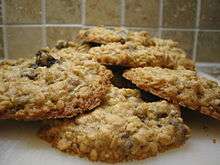Oatmeal raisin cookie
 Oatmeal cookies with golden raisins, orange zest and chocolate chips | |
| Type | Cookie |
|---|---|
| Course | Dessert or snack |
| Place of origin | Scotland (oatcake); United States |
| Created by | Fannie Merritt Farmer (first recorded recipe) |
| Invented | 1896 |
| Main ingredients | Oatmeal, raisins |
| Ingredients generally used | Flour, sugar, eggs, salt, spices |
| Similar dishes | Oatcake |
.jpg)
An oatmeal raisin cookie is a type of drop cookie distinguished by an oatmeal-based dough with raisins mixed throughout. Its ingredients also typically include flour, sugar, eggs, salt, and various spices.[1] A descendant of the Scottish oatcake, the oatmeal cookie was eventually improved with raisins, and now the oatmeal raisin cookie is one of the most popular cookies in the United States.[2]
When the cookies were becoming prominent in the United States in the early 1900s, they came to be known as a "health food"[3] by reason of having increased fiber and vitamin contents from the oatmeal and raisins. Nonetheless, the nutritional value of an oatmeal raisin cookie is virtually equivalent to that of a chocolate chip cookie, with each having practically the same sugar, fat, calorie and fiber content.[4][5]
History
In the early Middle Ages, traditional Scottish oatcakes had similar ingredients but were and are typically crispier than modern oatmeal cookies.[6] The first recorded oatmeal cookie recipe was published in the United States by Fannie Merritt Farmer in her 1896 cookbook, the Boston Cooking-School Cook Book. While Farmer's original recipe did not contain raisins,[7] their inclusion grew more common over time, due in part to the oatmeal raisin cookie recipes featured on every Quaker Oats container beginning in the early 1900s.[8]
Controversy
Despite the overall popularity of oatmeal raisin cookies, the inclusion of "polarizing" raisins in the recipe has sparked some lighthearted controversy among the general public in the US.[9] While some praise the enhanced flavor and texture provided by the raisins, others believe that raisins do not belong in the cookies, and should be substituted or removed from the recipe. One common criticism is that oatmeal raisin cookies are easily confused for chocolate chip cookies, leading the raisins' tarter flavor to surprise an unsuspecting eater.[3]
Because of this stigma, and the fact that it is a cookie, but yet widely disliked or malpreferred, the oatmeal raisin cookie has grown to represent anything that is widely considered unfavorable. Television hosts such as Seth Meyers and John Oliver, for example, have used oatmeal raisin cookies in political analogies or jokes to describe or similize candidates and policies that are widely disliked.[10][11]
See also
- Anzac biscuit, made with rolled oats
- List of cookies
- Oatmeal Cookie (cocktail)
References
- ↑ Clark, Melissa. "Classic Oatmeal-Raisin Cookies". NYT Cooking. The New York Times. Retrieved 12 July 2018.
- ↑ Amatulli, Jenna. "The Definitive List Of America's Favorite Cookies". HuffPost. Retrieved 12 July 2018.
- 1 2 Dockray, Heather. "The stigma against oatmeal raisin cookies". Mashable. Retrieved 12 July 2018.
- ↑ Balagur, Amanda. "Are Fruity Desserts A Healthier Choice? Nutritionists Tell All". HuffPost. Retrieved 12 July 2018.
- ↑ "Food Composition Databases". ndb.nal.usda.gov. Retrieved 2018-09-16.
- ↑ Cloake, Felicity. "How to cook the perfect oatcakes". The Guardian. Retrieved 12 July 2018.
- ↑ Perry, Sara. "Oatmeal cookie completeness". OregonLive. The Oregonian. Retrieved 13 July 2018.
- ↑ DiLonardo, Mary Jo. "The tasty history of 9 mouthwatering cookies". Mother Nature Network. Retrieved 13 July 2018.
- ↑ Druckman, Charlotte. "The Best Oatmeal Cookie Recipe We've Ever Tried". The Wall Street Journal. Retrieved 12 July 2018.
- ↑ Wilstein, Matt. "Seth Meyers Rails Against Paul Ryan for Trumpcare Hypocrisy". The Daily Beast. Retrieved 12 July 2018.
- ↑ Romano, Andrea. "John Oliver uses gross raisin cookies to demonstrate what a Trump presidency would be like". Mashable. Retrieved 12 July 2018.